My photo-diary of the Buddhist temple, Shanti (“Peace”) Stupa in Leh, Ladakh, India.
View it here:
Or on YouTube:
My photo-diary of the Buddhist temple, Shanti (“Peace”) Stupa in Leh, Ladakh, India.
View it here:
Or on YouTube:
Ah, so it’s been 4 months since my last post. I have no excuse. Continuing right along about my Himalayan trekking adventure. After roaming around Leh and slowly acclimatizing on Saturday, the next day, Sunday, July 26, 2015, we made a short visit to the Shanti Stupa.
A stupa is a Buddhist shrine. “Shanti Stupa is situated at a height of 4,267 meters overlooking the Leh city . . . was built by the Ladakh and Japanese Buddhists, Ladakhis offered voluntary labor, construction started in 1983 and it was inaugurated in August 1991 by His Holiness The Dalai Lama. It was built to promote world peace and prosperity and to commemorate the 2,500 years of Buddhism.”
(Source: http://jktourism.org/index.php/shanti-stupa)
It was about a 20 minute walk from where Ravi and I were staying to the Shanti Stupa. I am feeling relatively normal today. We leave at around 7:30 a.m. It is nice and cool outside, very few people are out, and we leisurely stroll over to the foot of the shrine. We see some early birds who are already ahead of us, climbing the 500 steps up to the shrine.
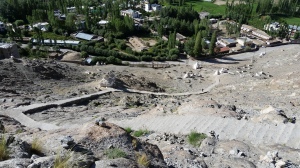
It is approximately 8 a.m. We are heating up from the effort of climbing, and from the sun getting stronger, too. We take a few breaks while climbing the steps to enjoy the scenery and catch our breath. High altitude makes everything tougher.
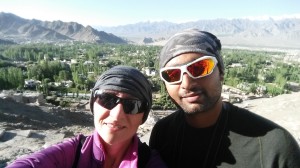
At last, we make it to the top in about 30 minutes. The shrine is not immediately visible. We take a few more steps climbing around the shrine until she slowly reveals herself. In her majestic whiteness. So striking against a most clear blue sky.
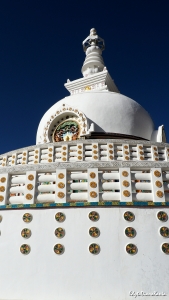
We slowly walk around the shrine in a counterclockwise direction, as instructed by a sign. We admire the intricate details of the artwork. We take our shoes off at the base of the shrine and walk up a few more steps to get closer.

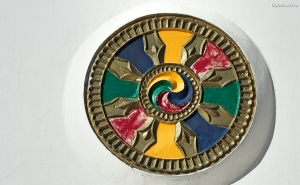
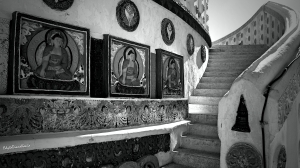

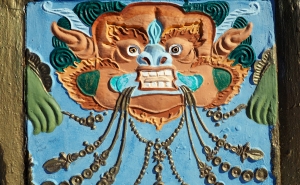


We take a short break at the base of the steps of the shrine, make a small donation, and enjoy the peaceful view on Leh. It is so silent here. We rest. I am happy that I survived this short excursion of physical activity. Time is slipping away, and we have to make final arrangements today if we are to trek tomorrow.
After we descend from the shrine, we enjoy a mid-morning breakfast at a cafe. I am feeling really good now since my high altitude sickness seems to have subsided, I survived a short climb, and I am also feeling an extra kick of optimism after a delicious iced coffee.
As we slowly make our way back toward our homestay, we see a crowd of people gathered on a bridge to have a better look down at the river. There is a huge fallen tree causing a blockage. The obstruction is being removed. In hindsight, the tree was taken down by the force of the rising waters and carried down with the current.
Later on in the day, we find out that the road at the usual entry point into Markha Valley is blocked. So, we are going to attempt the trek from the opposite direction. We do some final shopping today, arrange for a taxi for tomorrow morning, pack, and go to sleep.
Next: Day 1 – Shang Sumdo – our entry point into Markha Valley.
I survived my first day in Leh – mostly be sleeping through the exhaustion and high altitude sickness. The next day – Saturday, July 24, 2015 – Ravi and I pass time by getting to know our immediate surroundings, talking to agents about our intended Markha Valley trek route, and acclimatizing to the high altitude. There isn’t anything that can be done to speed up the process of acclimatization. Every body is different. It may take several days to feel normal again. See below for some of my personal tips on acclimatizing better.
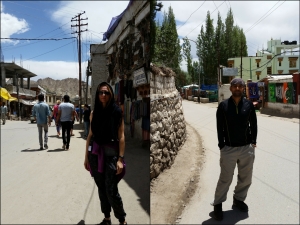
Climate is dry in this city of 3,500m. It is a high altitude desert where the sun is strong. In July, days are hot and nights are cool. Today, temperatures reach 90F (32C) while at night it is a pleasant 64F (18C). The main street is busy with laid back pedestrians competing for walking space with aggressively moving vehicles and motorbikes. Honk, honk. Every motorized vehicle honks to let you know they are coming. Cows, donkeys, and stray dogs roam freely. I’ve never witnessed aggression from any animal here. Dogs bark – but at each other. It makes me wonder why dogs in the States are so aggressive. Maybe because they don’t have enough freedom to just be.
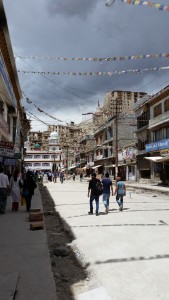
Dust and the smell of gasoline permeate the atmosphere. A scarf is a must – offering protection from the sun, swirling dust, and pollution. At times, the winds will bring on sudden rains making the temperatures drop drastically. Then you feel the chilled mountain air. Locals wear sweaters and jackets even though it may be 90 degrees. Power goes out regularly during the day. Shop owners then will crank up their generators and the smell of gasoline may get quite overwhelming. Cafes and restaurants entice customers with free WiFi except the optical fiber cable supplying Leh with internet was damaged due to atypically heavy rains while we were there.
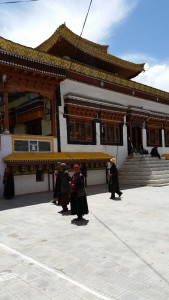
Tourism, trekking, and mountaineering business thrives in Ladakh during the summer months. The remainder of the year it is too snowy and cold for access by road. The main street and markets in Leh are peppered with homestays (a room with bathroom in a locally owned house), tourist agencies, mountaineering equipment rental shops, trekking clothing shops, yak wool scarf and souvenir shops, Tibetan refugee markets, restaurants, and ATM machines. Many of the popular brand name products sold here to trekkers and mountaineers like pants, jackets, and backpacks are knock offs. Most look a lot like the real thing.
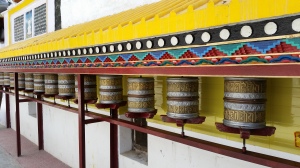
Some of my personal tips for acclimatizing better to the climate here are to keep a bottle of water on you at all times and drink from it regularly. I can’t intake 1 liter of water in one sitting so I have to spread it out. A female my size (5’5″ – 120lbs) will need something like 4 to 6 liters per 24 hours. If you neglect your water intake, you’ll get a headache, feel lousy, and be a downer to your group. It might take you several hours to feel good again. Also, stay away from walking around in direct sun when it’s high. You will dehydrate very quickly and you will have sunstroke before you know it.
If you are a Westerner, keep in mind too that most foods here are spicy and/or salty. Don’t count on the cook making the food less spicy for you because what is less spicy to them might still give you diarrhea which will cause you more dehydration. However, Tibetan food is also served here. This food is bland actually and mild on the stomach. Try momos – boiled Tibetan dumplings. Additionally, tea is very popular. Black tea is most common. If you ask for chai – you will get black tea with milk, sugar, and spices.
But there is also lemon, mint, and ginger teas. These teas aren’t made from tea sachets – they are actual lemon juice, mint leaf, and ginger root – each made with hot water and served in a small glass. In the evening when the sun has set and you are feeling cold, indulge in hot lemon ginger “tea” (freshly grated ginger with lemon juice and hot water) – the ginger will warm you. Ginger does have a spicy taste if you intend to chew on it, but it is good for opening up capillaries and helping the body acclimatize.
As I am on the topic of tips and in case you have not been to India before – keep in mind that toilets here are very different from the Western toilet. It is one where you squat and go. Most likely there will be no paper, and since a Westerner is not used to the washing technique but rather prefers wiping with paper – carry paper with you, but do not flush it down the toilet. Paper always goes into the trash – here known as “dust” bin. Carry wipes and/or hand sanitizer. Lastly, if you’re staying out late, once the sun sets – roads are dark, power may be out, and the toilet may be pitch black – so always have a torch on you for lighting your path.
Next: Visit to the Shanti Stupa in Leh.
It is July 23 shortly before midnight. I am in Delhi again, with my pack on. Ravi – outfitted with his own pack – is waiting for me outside the international arrivals terminal. I come out to meet him with a handshake. Delhi is hot and muggy on this July night. The airport is wide awake. Pushing our bags on a cart, we take a short walk over to domestic departures. The armed guard at the door is curious about us and strikes up a conversation with Ravi in Hindi. The guard seems oblivious to the fact that many people are lining up behind us with their luggage waiting to gain entry into the airport too.
I slowly start to make my way through the doors to break up the conversation. We walk into the departure hall and our luggage is screened. Now we wait for the Air India counter to open up so that we may check in for our flight to Leh. The counter won’t be open for another 3 hours though. I am feeling delirious at this point from lack of sleep. It is noon Chicago time and almost 24 hours since I’ve left home for this trip. I’ve slept 4 to 5 hours on my two flights to Delhi. Our flight for Leh is scheduled to leave at 5:50 a.m. Just a few more hours and I’ll get to rest.

We find a seat and reorganize our bags. We sit and talk. I lie down on the benches. Many others are doing the same. I try not to close my eyes for too long. I could sleep for many hours. We walk over to Air India as soon as we see it open up for business. Immediately, there is a long line with passengers awaiting to check in their luggage. Most passengers have more than one bag. The check in process is slow. The staff is half asleep. It is 4:00 a.m.
At last, we’re checked in and we take a long slow stroll to our gate. The airport is nearly deserted here. I am beyond tired. I take my first diamox. We still have 1.5 hours until take off. As we continue to pass time, Ravi strikes up another conversation with a fellow traveller from India who is a self-taught mountaineer. He will be attempting Mt Stok Kangri. Stok Kangri is not too far from where we will be trekking.
Our flight for Leh is on time. It is a short flight. As we near Leh, the sun rises and we get spectacular views of snow covered mountains below. Passengers notice the views and begin taking pictures. As we get closer to Leh, we are quickly warned by the flight attendant that photos of Leh are prohibited. It is a military base.
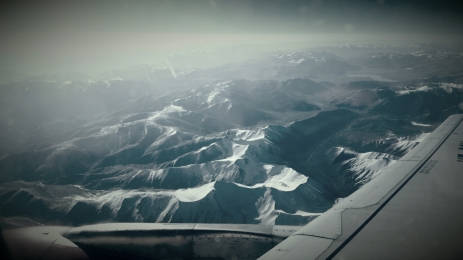
We land in Leh, disembark the plane, and are bussed over to the main airport. Leh is a small port similar to the one in Bagdogra. I wonder to myself how this trek will compare to Goechala from the year before. I’m handed a foreigner registration card as soon as I enter the airport. There is no need to ask me if I’m a foreigner.
As we wait for our luggage, a friendly prerecorded female voice plays in the background. The recording warns of high altitude sickness. We are at the altitude of 3,500 meters or approximately 11,000 feet. The female voice cautions to take sufficient rest and hydration, and to see a doctor if not feeling well. In addition, a large sign advises passengers to pay attention to symptoms of high altitude sickness. If untreated, it can be deadly.
We collect our bags. Many people arriving here are backpackers. Within a few minutes of arrival, my delirious sleepless state is met with intense sinus pressure and a roller-coaster-type nausea. I tell Ravi I’m not feeling good. I have to sit down. I scan the faces of other travelers to see if they are also feeling unwell. Everyone is quiet. It’s hard to tell if they are sick or simply exhausted. I’m reluctant to get into a taxi for fear that I might vomit. Most people have left the airport and I can tell that I won’t be getting better any time soon. We have to go.
At 7 a.m., it’s a sunny and hot day. It is both hot and cold. Swift mountain chilled breezes break up the intensity of the sun. I squint my eyes. It is a high altitude desert with sparse vegetation. The earth is in pale shades of gray, taupe, and brown. The sky, a virgin blue.
Our taxi takes us toward the center of the city. We are there within a few minutes. I am glad the car has stopped as I wouldn’t be able to keep myself from getting sick much longer. Ravi goes to make arrangements with our homestay. I close my eyes and wait. Happy to be motionless.
It is approximately 7:30 a.m. We find the homestay down a narrow cobbled path among numerous other homes separated by tall stone walls. We have arrived. We have a sunny second floor room with large windows and a bathroom. It is quiet and peaceful here. The power is out. I will find out soon enough that it goes out on a regular basis in Leh.
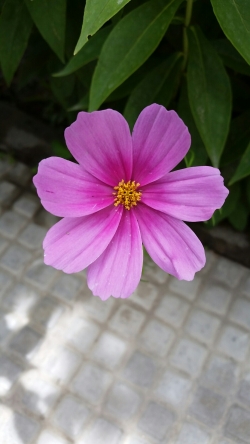
I lie down immediately and drift off to sleep. I wake every couple of hours, drink some water, and pee. When I wake up, I seem to eliminate more fluid than I intake. Almost like clockwork at 10:30 a.m., 1:30 p.m., 3:30 p.m., 5:30 p.m. I’m awake again thinking, it’s so nice outside, we should go for a walk. But I can’t keep my eyes open. My body feels heavy. I drift off to sleep again.
Ravi falls asleep too. He also hasn’t slept the night before. It is 7:30 p.m. The sun will be setting soon. I’m feeling half way normal. We go outside into the city. It is a hustling, bustling, car honking, dusty environment. My energy is zapped but I’m up – walking.
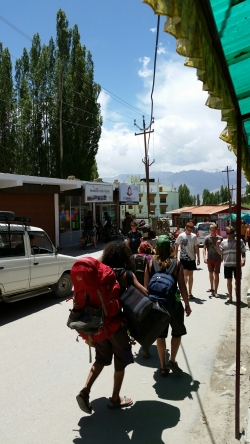
Next: Roaming in Leh.